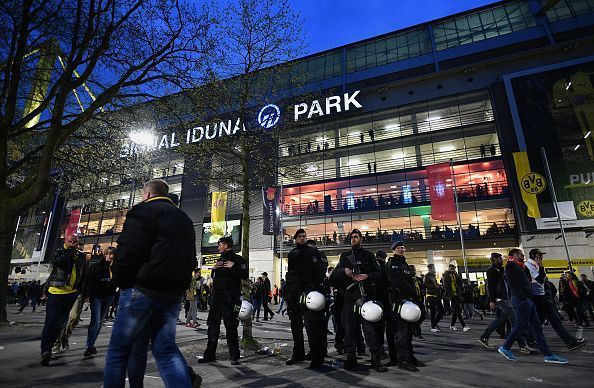Stadiums are more than a venue to see sports. Real fans show their passion in a football stadium. The atmosphere during an intense match is like a battle between two sides.
Stadiums play an important role in the history of sports and they have evolved with the times. Club management seek the help of engineers to create some of the best masterpieces.
In football, they carry action, emotion, drama and passion with them. The spectators are happy here, they dance and cheer on the stadium chairs, but when depressed their frustration is released on the same stadium chairs.
Most football stadiums outside Europe play many roles including hosting other sports. But when it comes to football its true purpose emerges. Here are 5 of the largest stadiums in the world of football:
5. Signal Iduna Park, Dortmund (GERMANY)
Capacity: 81,365
Home to Borussia Dortmund.
BVB fans readily accepted their temple with great pride. And the club's marvellous attendance record in recent years attests to this. A breath-taking work of construction and phenomenal fans provide the club with the optimal conditions to host many great football spectacles in the greatest (and biggest) ground in the Bundesliga.BVB
To be exact, it can now hold exactly 81,365 spectators due to the reconstruction measures taken prior to the 2006 World Cup (including the removal of the last seat shells from 1974 and the demolition of the front sections) and the modernisation work carried out before the 2012/13 season.
4. Borg El Arab Stadium, Alexandria (EGYPT)
Capacity - 86,000

Egyptian Football Association, Al Ittihad Alexandria Club, Smouha SC use this as their home.
This was part of the construction project to build five stadiums to support the bid by Egypt to host the 2010 football World Cup. It is the largest stadium in Egypt and the second largest in Africa (after the stadium in Johannesburg) with a capacity of 86,000 and is an all-seated. It is also the 27th largest stadium in the world and the 9th largest association football stadium in the world.
3. Estadio Azteca, Mexico City (MEXICO)
Capacity - 87,000
Home stadium - Club América ,Cruz Azul , Mexico national football team

Estadio Azteca officially opened on 29 May 1966 with a friendly match between América and Italian side Torino (2-2 result). During the 1970 World Cup, it hosted a total of 10 matches, among which a semi-final and the final between Brazil and Italy (4-1 result).
Sixteen years later, Estadio Azteca again hosted a World Cup final, and until 2014 it had been the only stadium to host two World Cup finals (now sharing the record with Maracana). The stadium had received a small renovation before the start of the World Cup and went on to host 9 matches, among which the famous quarter-final between Argentina and England (2-1), a semi-final, and the final between Argentina and Germany (3-2).
In the following decades, safety measures brought back capacity from 115,000 in 1986 to around 100,000 in the 2000s. In 2016, the stadium underwent a large refurbishment including the addition of VIP facilities, which reduced capacity to 84,000 seats.
The stadium was also the principal venue for the football tournament of the 1968 summer Olympics.
2. FNB STADIUM, Johannesburg (SOUTH AFRICA)
Capacity - 94,736
Home stadium - Kaizer Chiefs, South Africa national football team

The original stadium had a capacity of 80,000. It was later upgraded by extending the upper tier to increase the capacity to 94,700, adding 99 more suites to bring the number to 184, constructing an encircling roof and adding new changing room facilities and installing new floodlighting. Among the most artistic and awe-inspiring football venues on the African continent, the reconstructed Soccer City stadium (FNB Stadium) hosted the first and final matches of the 2010 World Cup.
The stadium is widely regarded as the heart of football in South Africa as it has hosted many important matches. It was also the venue for the 1996 CAF Africa Cup of Nations final, with South Africa eventually triumphing 2-0 over Tunisia.
1.CAMP NOU, BARCELONA ( SPAIN )
Capacity - 99,354
Home stadium - FOOTBALL CLUB OF BARCELONA

This pitch has witnessed the greatest comeback in football history, recovering a four-goal deficit against PSG. With a capacity of 99,354, it is now the biggest stadium in Europe. However, the total capacity has varied over the years owing to different modifications. When it was first opened in 1957, it held 93,053 spectators, which increased to 120,000 in 1982 on occasion of the FIFA World Cup.
However, the introduction of new regulations outlawing standing areas reduced the stadium’s capacity in the late 1990s to just under 99,000 but it remains an iconic stadium.

